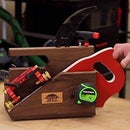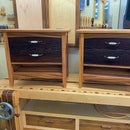Introduction: Table Saw Jigs
After many years of service, my trusted table saw finally bit the dust. I purchased a new saw that should be an upgrade once I get the kinks worked out. Unfortunately, the replacement saw fence size is slightly larger which requires updates to my jigs. While updating them, I decided to create an instructable that others might find useful.
Even though I really didn't need plans to build these jigs, I'd like to toss a huge "Thanks" to mtairymd for his work on putting the plans together! You can get the plans from my website and I've also included them here in the final step.
The build and drawings for the Miter and Tenon jigs are shown in the steps. This video fills in the missing info.
Step 1: Tools and Materials
The following tools and materials are needed to complete the 2 jigs.
Tools:
- Table Saw
- Miter Saw (Optional)
- Drill
Materials:
- 3/4" plywood
- 3/4" hardwood
- Toggle Clamps
Step 2: Miter Jig (1 of 3)
The purpose of this jig is to add splines to mitered corners. Whether it's a door, a picture frame, or any other mitered corner, these joints benefit from the additional glue surface that a spline provides making the joint stronger than just an end grain glue up. This jig is designed to utilize the table saw fence to help locate these splines and make for repeatable cuts.
As described in the video, this jig starts with the base that is designed to fit the intended table saw fence being used. It's important that this base doesn't fit too tightly on the fence or it won't slide easily. It's also important that the base doesn't fit too loosely on the fence as that could produce cuts that are a little off from one corner to the next.
Step 3: Miter Jig (2 of 3)
This step shows the drawings used for the Miter Jig build. Note that adjustments will need to be made based off your fence size. To find the best fit for your fence, measuring the width of your fence plus a folded piece of printer paper gives the best fit to ensure that it's not too tight or too loose.
Step 4: Miter Jig (3 of 3)
The parts are cut per the plan and then assembled using glue and brad nails to hold the parts together. Once the glue sets up, screws are added to reinforce the glue joints. The support pieces were cut from hardwood but, could be made from plywood as well. These are spaced evenly on the back of the jig to support the plywood face above the level of the fence. This ensures that the face of the jig remains flat and perpendicular to the saw blade. This is especially important if clamps are used to hold the workpiece to the face of the jig.
The miter blocks are made using three pieces of 3/4" plywood laminated together. They are then cut at the miter saw to produce a 45-degree angle on each side. These blocks are then attached to the blade side of the fence using glue and clamps until the glue dries. It's important to not use screws that could be in the path of the table saw blade. A handle is mounted on the user end of the jig to assist with pushing the jig along the fence.
Step 5: Tenon Jig (1 of 3)
The tenon jig is used to cut the cheeks of tenons at the table saw. This jig is designed to give repeatable cuts without changing out the standard blade at the table saw.
Step 6: Tenon Jig (2 of 3)
This step shows the drawings used for the Tenon Jig build. Again, adjustments will need to be made based off your fence size.
Step 7: Tenon Jig (3 of 3)
The base of this jig is built exactly the same way as the miter jig. The only difference with this jig is that the support for the extra height above the fence comes from a box structure above the fence.
Once the pieces are assembled using glue and brad nails, screws are added to additional support. A hardwood strip of 3/4" material is added using glue and screws on the blade side of the jig at the user's end of the jig. This board is used to mount the toggle clamps as well as being a backer for any tenon cheeks being cut. It's important that no screws are added below the expected height of the table saw blade. The last items to install are the toggle clamps. These should be adjustable to handle different material thicknesses that you may want to use.
Step 8: Closing
Although I use the miter jig far more than the tenon jig, I find them both extremely handy to have in the shop! They're quick simple builds that cost little more than scraps that can usually be found in most shops. The toggle clamps will cost a few dollars but, can also be easily removed and used on other shop jigs.
Thanks for viewing!
Some links are affiliate links so making a purchase helps support my work.
Attachments

Participated in the
Build a Tool Contest














